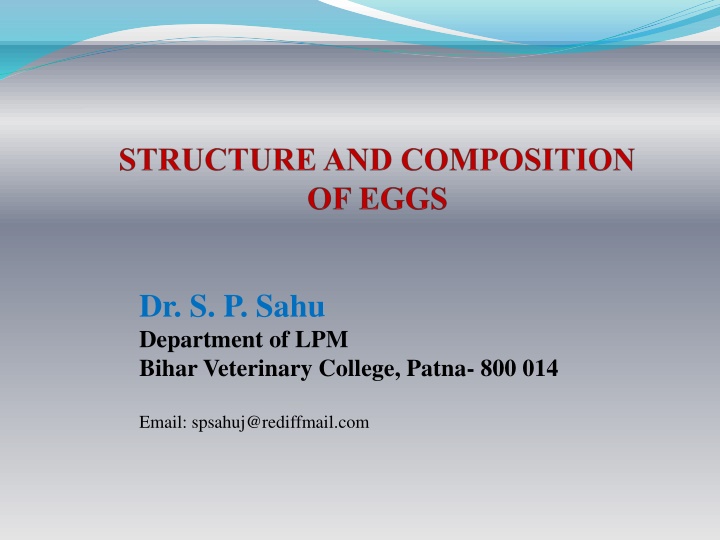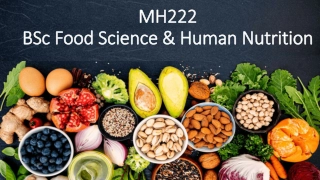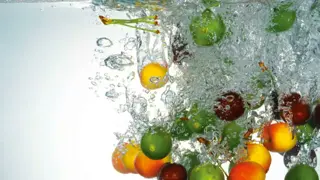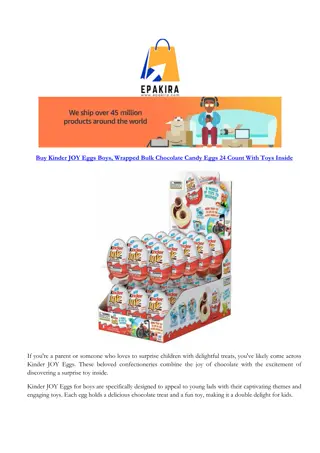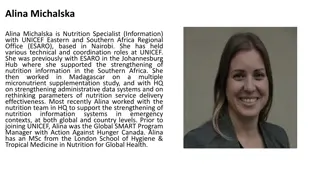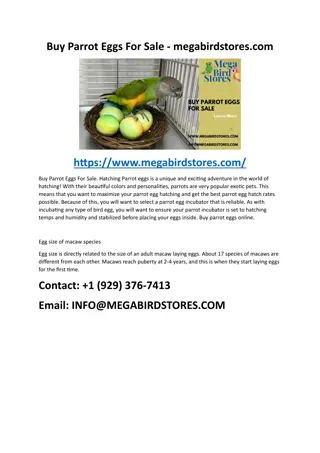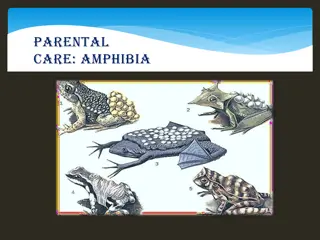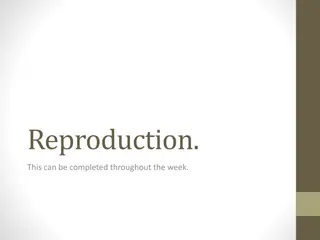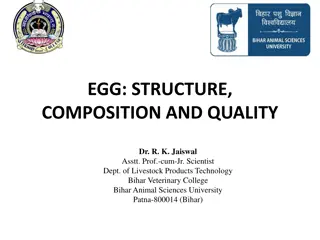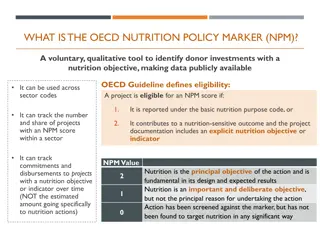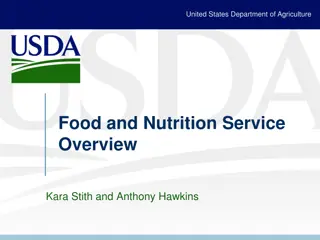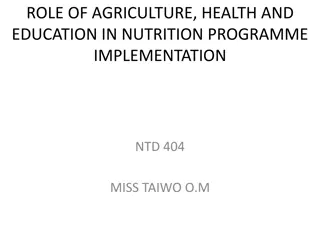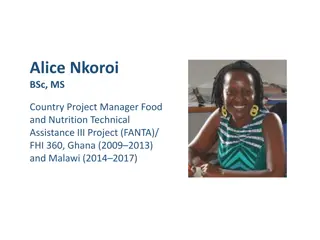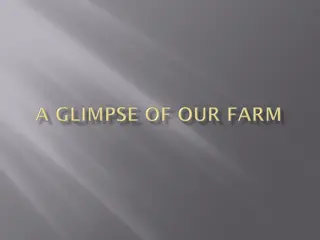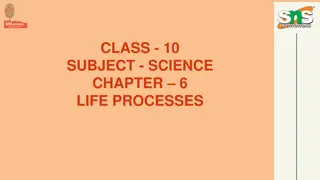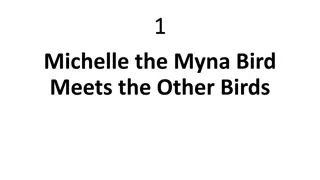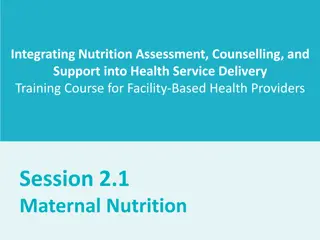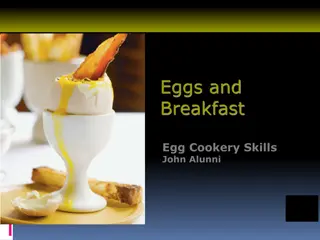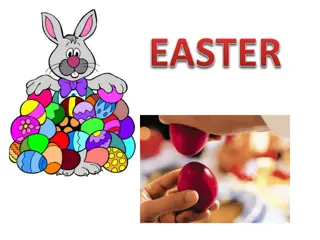Composition and Nutrition of Various Bird Eggs Explained
Are you curious about the structure of an egg and its nutritional value? Explore the composition of eggs from different bird species. Learn about the layers of egg white, yolk colors, and nutrient breakdown. Discover how the shell acts as a protective barrier and the importance of each component in an egg.
Download Presentation

Please find below an Image/Link to download the presentation.
The content on the website is provided AS IS for your information and personal use only. It may not be sold, licensed, or shared on other websites without obtaining consent from the author.If you encounter any issues during the download, it is possible that the publisher has removed the file from their server.
You are allowed to download the files provided on this website for personal or commercial use, subject to the condition that they are used lawfully. All files are the property of their respective owners.
The content on the website is provided AS IS for your information and personal use only. It may not be sold, licensed, or shared on other websites without obtaining consent from the author.
E N D
Presentation Transcript
Dr. S. P. Sahu Department of LPM Bihar Veterinary College, Patna- 800 014 Email: spsahuj@rediffmail.com
Structure of an Egg 1. Germinal Disc 4. Shell 5. Outer Shell Membrane 6. Inner Shell Membrane 7. Air Cell 8. Chalaza 9. Dense White 10. Inner Thin White 11. Outer Thin White 12. White Yolk 13. Yellow Yolk 2. Vitelline Membrane 3. Chalaziferous of White
Shell The shell of an egg is porous to allow the developing chick to obtain oxygen. The pores also allow water and carbon dioxide to escape. Other than oxygen, bacteria and odours can enter the egg. The membrane that lines the inside of a shell acts as a filter to protect against bacteria. At one end of the egg, the membrane separates into an air space to supply the chick with oxygen. The shell is generally strong but the older birds tend to produce weaker shells. The shell s colour varies according to the breed of the bird.
Egg white There are two layers of egg white: 1. The thick white layer (nearest to the yolk) 2. The thin white layer (nearest to the shell) Yolk The colour of the egg yolk is related to the diet of the hen and is due to the presence of carotenes and colourings added to a hen s feed. The nutritional value of the egg is not affected by the colour of the yolk. Eggs are a good source of high biological-value protein and easily digested. 88.5% of an egg is edible.
Composition of egg of various birds S. No. Birds Egg weight (g) Yolk (%) Albumin (%) Shell (%) Chicken 50 31 58 11 1. Quail 10 32 48 20 2. Turkey 65 32 56 12 3. Duck 72 35 53 12 4. Pigeon 18 18 74 8 5.
Nutritional value of egg The nutritional content of egg white is: 10.5% protein 88.5% water riboflavin and other B vitamins a trace of fat. The nutritional content of egg yolk is: 16.5% protein 33% fat 50% water fat-soluble vitamins A, D, E and K mineral elements, including iron lecithin (an emulsifier).
Nutrient composition (%) of chicken egg S. No. Nutrients Whole egg Yolk Albumin Shell & Membranes Major - 31 58 11 1. components Water 65 48 84 2 2. Protein 12 17.5 11 - 3. Fat 11 32.5 0.2 - 4. Carbohydrate 01 01.0 1 - 5. Ash 11 1 0.8 93.5 6.
Sizing of eggs: Chicken eggs are graded by size for the purpose of sales. Very large: 73 g and over, Large: 63-73 g, Medium: 53-63 g and Small: 53 g and under. Use of Eggs: Thickening. To thicken custards, sauces, soups, etc., because of the coagulation of the egg proteins. Emulsifying. Egg yolk contains lecithin, which is an emulsifier and enables oil and water to be mixed without separating. It is used in making mayonnaise and cakes. Binding. Ingredients for rissoles, croquettes, and meat or fish cakes can be bound together with egg. Coating. Coating for fried foods because they form a protective layer on the outside of the food. Glazing. Egg yolk, egg white or whole egg is brushed over pastries and bread to produce a golden brown shiny glaze during baking.
Composition of Chicken, duck and Quail meat S. No. Nutrient Chicken meat Quail meat Duck meat 1. Water 66.00 62.65 53.88 2. Protein 20.20 26.00 13.48 3. Fat 12.60 03.30 19.68 4. Minerals 01.20 03.20 2.74 5. K cal/100 g 155 80 326
CULLING OF POULTRY Culling is a procedure to separate uneconomical and diseased birds from the layer flock. Natural phenomenon that there will some birds, which will not grow well and ultimately will become poor layers and uneconomic. Culling should be done during night hour to avoid undue stress on birds due to excitement and handling. 1. Condition of bird: It includes health of the bird such as tight feathering with tail and wing feather, bright expression and alertness. Lack of condition is exhibited by the appearance of comb and eye. Birds showing pale and shrunken comb, emaciated face, thin breast, drooping wings and tail feathers should be culled.
Characteristics of good and poor layers Character Good layer Poor layer Head and nature Strong, Square and broad at the top. All parts well- proportionate. Feminine in female and Masculine in male Coarse, crow headed, narrow, tendency to masculine in female and feminine in male Comb and wattle Beak Full, red, waxy and warm Short and solid well curved Dry, scaly and cold Narrow, very long, thin sharp and pointed. Shrunken, wrinkled, off colour than breed. Dull, sleepy Yellow Long and thin Limited capacity, Narrow not Straight Shallow, Barrel shaped Closer to each other, thick and Stiff, distance in between loss than 2-3 fingers. Less than 2-3 fingers. Earlobes Full, waxy, colour as per breed specification Bright, alert and well set Bleached, thin and flat Bleached Stocky and rather short Capacious, broad and straight Deep and straight Wide apart, thin soft and pliable Distance in between more than 2-3 fingers. More than 4-5 fingers Eye Ear lobes Neck Body Back Pubic bone Distance keel and pubic bones between
Character Good layer Poor layer Skin Thin, Soft, oily and silky Thick, dry rough and under laid with fat. Abdomen Vent (for females) Plumage Large, soft and moist. Free from fat Large, oval and moist Tight, compact colour specific for breed Small, hard and fat deposits Small dry and round Loose, scattered off colour from breed Legs Shank Toe nails Temperament Appetite Thin, soft and heat at back Dry old bristle soiled Stocky well curved Friendly and always happy Heavy eater and crop always nearly full Thick hard and rounded at back yellowish, round, full Long, thin and sharp pointed Shy, nervous frighten when caught Poor eater, crop is near to empty Pigmentation Pigment disappears from beak skin, vent shank and wings as laying advance and they will appear faint in colour Pigmented beak, skin and wings are brightly coloured. Vent Time of moulting Bleached, large oval and moist Late and quick Yellow round small Early and slow
2. Moulting patterns: Moulting is a natural physiological process to shed old feathers with new feathers at the end of first year of laying. Early moulters (Before 72 weeks of age) are usually poor layers. Such birds start moulting at early age and take unusual long time (24 weeks time) to complete moulting. Often these birds stop laying during moulting periods. They shed only on primary feathers, complete the moulting quickly by shedding two or more primary feathers together and complete the moulting with 4-8 weeks period.
3. Depigmentation: There is abundance of yellow pigments in the different parts of body of pullets. This is due to the deposition of carotenoid pigment mainly xanthophyll which comes from feed. As the pullets come in egg production, these pigments are transferred from body to eggs. The depigmentation in good layer follows a particular pattern depending upon the blood circulation. The order in which it disappears first from vent eye ring- ear lobes- beak (beginning at the base and extends towards tip)- shank (first at the front and then at rear side). 4. Sexual maturity: Good layers mature earlier within 18-20 wks. The birds which mature after 22 weeks should be culled out.
